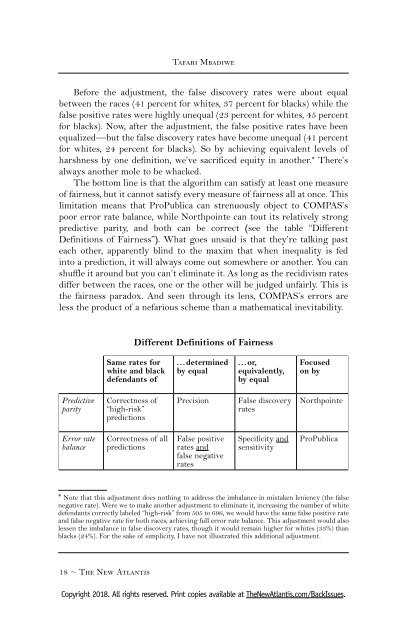The New Atlantis - Winter 2018 (Issue 54) uncompressed with cover
You also want an ePaper? Increase the reach of your titles
YUMPU automatically turns print PDFs into web optimized ePapers that Google loves.
Tafari Mbadiwe<br />
Before the adjustment, the false dis<strong>cover</strong>y rates were about equal<br />
between the races (41 percent for whites, 37 percent for blacks) while the<br />
false positive rates were highly unequal (23 percent for whites, 45 percent<br />
for blacks). Now, after the adjustment, the false positive rates have been<br />
equalized — but the false dis<strong>cover</strong>y rates have become unequal (41 percent<br />
for whites, 24 percent for blacks). So by achieving equivalent levels of<br />
harshness by one definition, we’ve sacrificed equity in another. * <strong>The</strong>re’s<br />
always another mole to be whacked.<br />
<strong>The</strong> bottom line is that the algorithm can satisfy at least one measure<br />
of fairness, but it cannot satisfy every measure of fairness all at once. This<br />
limitation means that ProPublica can strenuously object to COMPAS’s<br />
poor error rate balance, while Northpointe can tout its relatively strong<br />
predictive parity, and both can be correct (see the table “Different<br />
Definitions of Fairness”). What goes unsaid is that they’re talking past<br />
each other, apparently blind to the maxim that when inequality is fed<br />
into a prediction, it will always come out somewhere or another. You can<br />
shuffle it around but you can’t eliminate it. As long as the recidivism rates<br />
differ between the races, one or the other will be judged unfairly. This is<br />
the fairness paradox. And seen through its lens, COMPAS’s errors are<br />
less the product of a nefarious scheme than a mathematical inevitability.<br />
Different Definitions of Fairness<br />
Same rates for<br />
white and black<br />
defendants of<br />
...determined<br />
by equal<br />
...or,<br />
equivalently,<br />
by equal<br />
Focused<br />
on by<br />
Predictive<br />
parity<br />
Correctness of<br />
“high-risk”<br />
predictions<br />
Precision<br />
False dis<strong>cover</strong>y<br />
rates<br />
Northpointe<br />
Error rate<br />
balance<br />
Correctness of all<br />
predictions<br />
False positive<br />
rates and<br />
false negative<br />
rates<br />
Specificity and<br />
sensitivity<br />
ProPublica<br />
* Note that this adjustment does nothing to address the imbalance in mistaken leniency (the false<br />
negative rate). Were we to make another adjustment to eliminate it, increasing the number of white<br />
defendants correctly labeled “high-risk” from 505 to 696, we would have the same false positive rate<br />
and false negative rate for both races, achieving full error rate balance. This adjustment would also<br />
lessen the imbalance in false dis<strong>cover</strong>y rates, though it would remain higher for whites (33%) than<br />
blacks (24%). For the sake of simplicity, I have not illustrated this additional adjustment.<br />
18 ~ <strong>The</strong> <strong>New</strong> <strong>Atlantis</strong><br />
Copyright <strong>2018</strong>. All rights reserved. Print copies available at <strong>The</strong><strong>New</strong><strong>Atlantis</strong>.com/Back<strong>Issue</strong>s.


